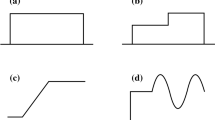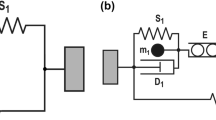Abstract
The frequency response model of the soleus muscle of the cat was determined as a function of various firing rate and recruitment control strategies and at various force oscillation levels. We found that the basic frequency response models of the muscle during individual force oscillations at various control strategies in which the motor unit population of the muscle was fully recruited to obtain 50 per cent and up to 100 per cent of the maximum force, either concurrently with firing rate increase or at constant firing rate, were nearly identical. The model consisted of a second-order, linear low-pass filter with double poles at 1·85 Hz and a pure time delay of 16 ms. The model resulting from only firing rate increase from the frequency of fusion of the smallest motor unit to the maximum tetanic rate of the muscle while all the motor units were continuously active was nonlinear, and depended on the force's oscillation level. This nonlinear response of the rate coding process is also identified as the source of the increased harmonic distortion in the model where the initial 50 per cent of the force was generated by fully recruiting all the motor units, and the final 50 per cent of the force was generated by firing rate increase. We concluded that the basic frequency response model of a muscle under conditions similar to voluntary contraction consists of a linear, second-order system which is robust and independent of control strategy and force perturbation level.
Similar content being viewed by others
References
Agarwal, G. andGottlieb, G. (1977) Oscillations of the human ankle joint in response to applied sinusoidal torque to the foot.J. Physiol.,268, 151–176.
Baratta, R., Ichie, M., Hwang, S. andSolomonow, M. (1989) A method for studying muscle properties under orderly stimulated motor units with tri-polar nerve cuff electrodes.J. Biomed. Eng., (in press).
Basmajian, J. andDeLuca, C. (1985)Muscles alive, 5th ed Williams & Wilkins, Baltimore, USA.
Bigland-Ritchie, B. (1981) EMG and fatigue of human voluntary and stimulated contraction. InHuman muscle fatigue; physiological mechanism. Ciba Foundation Symposium 82, Pitman Medical, London, 130–156.
Budingen, H. andFreund, H. (1976) The relationships between the rate of rise of isometric tension and motor unit recruitment in human forearm muscle.Pflügers Arch.,362, 61–67.
Coggshall, J. andBekey, G. (1970) A stochastic model of skeletal muscle based on motor unit properties.Math. Biosci.,7, 405–419.
Connolly, R., Gough, W. andWinegrad, S. (1971) Characteristic of the isometric twitch of skeletal muscle immediately after a tetanus.J. Gen. Physiol. 57, 697–709.
Cooper, S. andEccles, J. (1930) The isometric responses of mammalian muscles.J. Physiol.,204, 443–460.
DeLuca, C., LeFever, R., McCue, M. andXenakis, A. (1982a) Behavior of human motor units in different muscles during linearly varying contraction.,329, 113–128.
DeLuca, C., LeFever, R., McCue, M. andXenakis, A. (1982b) Control schemes governing concurrently active human motor units during voluntary contraction.,329, 129–142.
Evanich, M. andLourenco, R. (1976) Frequency response analysis of the diaphragmin vivo.J. Appl. Physiol.,40, 729–735.
Granit, R., Henatsch, H. andSteg, G. (1956) Tonic and phasic ventral horn cells differentiated by post-tetanic potentiation in cat extensors.Acta Physiol. Scand.,37, 114–126.
Hatze, H. (1976) The complete optimization of a human motion.Math. Biosci.,28, 99–135.
Hatze, H. (1977) A complete set of control equations of the human musculoskeletal system.J. Biomech.,10, 799–805.
Henneman, E., Somjen, G. andCarpenter, D. (1965) Functional significance of cell size in spinal motor neurons,J. Neurophysiol 28, 560–580.
Hill, A. (1938) The heat of shortening and the dynamic constants of muscle.Proc. R. Soc. London,126B, 136–195.
Inbar, G., Hsia, T. andBaskin, R. (1970) Parameter identification analysis of muscle dynamics.Math. Biosci.,7, 61–79.
Katz, B. (1939) The relation between force and speed in muscular contraction.J. Physiol.,96, 45–64.
Kukulka, C. andClamann, P. (1981) Comparison of the recruitment and discharge properties of motor units in human brachial biceps and adductor pollicis during isometric contraction.Brain Res.,219, 45–55.
Magdaleno, R., McRuer, D. andMoore, G. (1968) Small perturbation dynamics of the neuromuscular system in tracking tasks. NASA Report CR-1212, Washington DC.
Mannard, A. andStein, R. (1973) Determination of the frequency response of isometric soleus muscle in the cat using random nerve stimulation.J. Physiol.,229, 275–296.
McPhedran, A., Wuerker, R. andHenneman, E. (1965) Properties of motor units in a homogeneous red muscle (soleus) of the cat.J. Neurophysiol.,28, 71–84.
Milner-Brown, H., Stein, R. andYemm, R. (1973) The orderly recruitment of human motor units during voluntary isometric contraction.J. Physiol. (London),230, 359–370.
Partridge, L. (1965) Modifications of neural output signals by muscle: a frequency response study.J. Appl. Physiol.,20, 150–156.
Partridge, L. (1966) Signal handling characteristics of load moving muscle.Am. J. Physiol.,210, 1178–1191.
Rack, P. andWestbury, D. (1964) The effect of length and stimulus rate on tension in the isometric cat soleus muscle.J. Physiol. 204, 443–460.
Rack, P. (1966) The behavior of a mammalian muscle during sinusoidal stretching.,183, 1–14.
Solomonow, M., Eldred, E., Lyman, J. andFoster, J. (1983) Control of mucle contractile force through indirect high frequency stimulation.Am. J. Physical Med.,62, 71–82.
Solomonow, M. (1984) External control of the neuromuscular system.IEEE Trans.,BME-31, 752–763.
Solomonow, M., Baratta, R., Zhou, B.-H., Shoji, H. andD'Ambrosia, R. (1987) The EMG-force model of electrically stimulated muscle: dependence on control strategy and fiber type.,BME-34, 692–703.
Somjen, G., Carpenter, D. andHenneman, E. (1965) Selective depression of alpha motoneurons of small size by ether.J. Pharmacol. & Exp. Therapeutic.,148, 380–385.
Stark, L. (1968)Neurological control systems. Plenum Press, New York.
Tanner, J. (1962) Reversible blocking of nerve conduction by alternating current excitation.Nature (London),195, 712–713.
Taylor, R., Abresch, R., Lieberman, J., Fowler, W. andPortwood M. (1984) Effect of pentobarbital on contractility of mouse skeletal muscle.Exp. Neurol.,83, 254–263.
Wedensky, N. (1884) Wie Rasch Ermudet Der Nerv.Zentralblatt für die Medicinischen Wissenschaften 65–68.
Wilkie, D. (1950) The relation between force and velocity in humans muscles.J. Physiol.,110, 249–280.
Zahalak, G. andWeyman, S. (1979) A quantitative evaluation of the frequency response characteristics of active human skeletal muscle.J. Biomech. Eng.,101, 28–37.
Zheng, Y., Hemami, H. andStokes, B. (1984) Muscles dynamics, size principle and stability.IEEE Trans.,BME-31, 489–497.
Zhou, B.-H., Baratta, R. andSolomonow, M. (1987) Manipulation of muscle force with various firing rate and recruitment control strategies., 128–139.
Author information
Authors and Affiliations
Rights and permissions
About this article
Cite this article
Baratta, R., Zhou, B.H. & Solomonow, M. Frequency response model of skeletal muscle: effect of perturbation level, and control strategy. Med. Biol. Eng. Comput. 27, 337–345 (1989). https://doi.org/10.1007/BF02441424
Received:
Accepted:
Issue Date:
DOI: https://doi.org/10.1007/BF02441424




